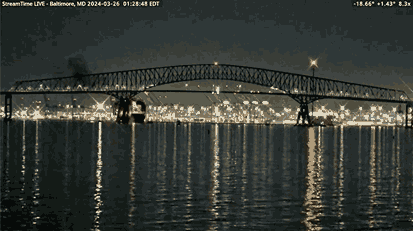This morning I discovered myself listening to the radio information as I often do – however there was one thing barely uncommon; I used to be being urged by the the host to have a look at the photographs of a bridge collapse in Baltimore. This was at round 7.30 within the UK, the place I’m, so solely about 2 hours after a container ship crashed into the assist tower of the 2-mile-long Francis Scott Key Bridge in Baltimore and destroyed it.
There was one thing uncommon about listening to somebody on the radio speaking a few visible picture with a touch of urgency. Certain, there are sometimes discussions about films with solid members, however it is not usually the medium dangers implying the information is healthier seen moderately than heard. This was totally different, so I grabbed my cellphone and, as instructed, watched. Solely then – with a horrifying silent readability – did I perceive the scope of the occasion described.
The huge cantilever bridge collapse, now little question being repeated throughout information channels, was recorded by a fixed camera at 1:28:50 EDT which streams on YouTube by StreamTime LIVE. It was arrange, apparently, as “a reside stream of the transport channel in Baltimore, Maryland, for individuals who get pleasure from watching ships.”
The result’s that my first information of this presumably lethal catastrophe – that is nonetheless unconfirmed as I kind, although it is onerous to think about in any other case – was merely being inspired to view it. I used to be left to type my very own impression from the photographs on display screen, although, in fact, a newsroom was rapidly getting engineers to remark and so forth. (Now, a bit of extra time has handed, however it’s nonetheless early within the day in Baltimore itself and a information convention is predicted quickly).
Nonetheless, that first impression – the one the world had for a number of hours, made me realise that our notion of occasions has modified a lot as we, as a society, have turn out to be used to viewing occasions by digicam lenses. Does it have a distancing impact? Or does it pressure us to assume a bit extra about what is going on – to be our personal newsroom? I do not know.
If I had been stood the place the StreamTime digicam was this morning, I doubt I might have been in a position to do a lot else however watch with horror. I am not saying that as a society we’re not searching for one another. I merely stay struck by the truth that we’re now so used to seeing issues by screens that movies exist – and are shared world wide – earlier than a message is hooked up. It feels a step farther from the “Breaking Information” intervention that shook the consciousness in 2001.
It is equally putting that there are such a lot of cameras round that occasions like this may be recorded in such wealthy high quality. Not way back it’d have taken hours or days to gather some CCTV digicam footage, however right here there was a digicam pointed straight at occasions and it was a matter of merely discovering it and scrolling the timeline again in YouTube.
Is the world of the longer term all the time going to be documented like this? Is it simply me who worries that it feels just a bit hole or is it OK that, as I watched, I realised how horrible this should be for these caught up in it and, just a few hours later, the information reporting appears to be catching up.
We preserve a information to the perfect digicam for streaming.


